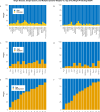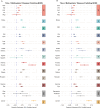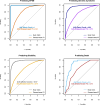Health octo tool matches personalized health with rate of aging
- PMID: 40325006
- PMCID: PMC12053696
- DOI: 10.1038/s41467-025-58819-x
Health octo tool matches personalized health with rate of aging
Abstract
Medical practice mainly addresses single diseases, neglecting multimorbidity as a heterogeneous health decline across organ systems. Aging is a multidimensional process and cannot be captured by a single metric. Therefore, we assessed global health in longitudinal studies, BLSA (n = 907), InCHIANTI (n = 986), and NHANES (n = 40,790), by examining disease severities in 13 bodily systems, generating the Body Organ Disease Number (BODN), reflecting progressive system morbidities. We used Bayesian ordinal models, regressing BODN over organ specific and all organs disease severities to obtain Body System-Specific Clocks and the Body Clock, respectively. The Body Clock is BODN weighted by the posterior coefficient of diseases for each individual. It supersedes the frailty index, predicting disability, geriatric syndrome, SPPB, and mortality with ≥90% accuracy. The Health Octo Tool, derived from Bodily System-Specific Clocks, the Body Clock and Clocks that incorporate walking speed and disability and their aging rates, captures multidimensional aging heterogeneity across organs and individuals.
© 2025. The Author(s).
Conflict of interest statement
Competing interests: The Health Octo Tool has a provisional patent (patent pending) by Sh.S. with the aim to make it digitally available to researchers. M.K. is a co-founder and shareholder of Optispan, Inc., and has expressed no conflict of interest with this work. The remaining authors declare no competing interests. This material should not be interpreted as representing the viewpoint of the US Department of Health and Human Services, the National Institutes of Health, or its represented agencies.
Figures








References
MeSH terms
Grants and funding
LinkOut - more resources
Full Text Sources
Medical

